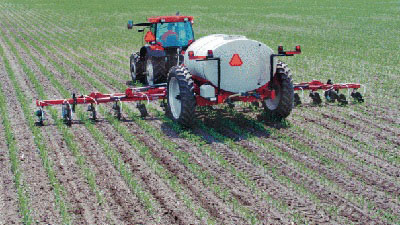
Agricultural News
Advice for the Cow/Calf Producer on How to Get a Pay Out When Fertilizing Your Bermuda Pastures
Fri, 07 Apr 2017 12:16:34 CDT
 The following is an article entitled The Economics of Fertilizing Bermudagrass for Cow-Calf Production, authored by Dr. Myriah Johnson, Agricultural Economist Consultant and Dr. Eddie Funderburg, Senior Soils and Crops Consultant of the Samuel Roberts Noble Foundation.
The following is an article entitled The Economics of Fertilizing Bermudagrass for Cow-Calf Production, authored by Dr. Myriah Johnson, Agricultural Economist Consultant and Dr. Eddie Funderburg, Senior Soils and Crops Consultant of the Samuel Roberts Noble Foundation.
Fertilizer prices have fallen in recent months. Unfortunately, so have cattle prices. Does it pay to fertilize bermudagrass pastures to increase carrying capacity in times like these? To answer this question, first you must determine how much carrying capacity is increased by fertilizing a pasture. Assume you have a 100-acre bermudagrass pasture in the Southern Great Plains on soils with average productivity and the year has average precipitation. Also assume pH, phosphorus and potassium are not limiting growth so the focus can be on nitrogen fertilization.
A pasture such as the one described will usually produce 2,000 to 3,000 pounds of dry matter forage per acre in a growing season with no fertilizer. This will vary depending on precipitation and bermudagrass variety, but this figure is applicable to most situations in this area. For our example ranch, we will assign the unfertilized grass a yield of 2,500 pounds of dry matter per acre. To maintain grass stand and soil health, we should leave at least 1,000 pounds of dry matter per acre in the field after grazing. This equates to a plant height of 3 to 4 inches. This means our field produces 1,500 pounds of grazeable dry matter per acre.
An average cow will consume about 10,000 pounds of dry matter per year. Using simple math, you can run one cow per 6.67 acres (10,000 ÷ 1,500) if you bale your own hay on the operation and do not fertilize. If you bring in a three-month supply of hay from off the ranch, you can increase the carrying capacity to one cow per 5 acres if you do not fertilize. This means your 100 acres can run 15 to 20 cows, depending on if you bale your own hay or bring it in from elsewhere.
Bermudagrass response to nitrogen fertilizer varies by variety, soil productivity and precipitation, but an average figure is that 1 pound of actual nitrogen will produce 30 pounds of dry matter forage above that amount produced with no fertilizer. A common nitrogen fertilizer rate in the Southern Great Plains is 50 pounds of actual nitrogen per acre (109 pounds of urea per acre). Thus, 50 pounds of nitrogen per acre will produce an additional 1,500 pounds of dry matter forage per acre (50 pounds N × 30 pounds of dry matter per pound of N). When this amount is added to the 2,500 pounds of dry matter forage per acre produced with no nitrogen fertilizer, the total amount of forage produced is 4,000 pounds per acre. We still leave 1,000 pounds of dry matter forage in the field for grass and soil health. This means we have 3,000 pounds of grazeable dry matter forage per acre in the fertilized field.
The cow still eats 10,000 pounds of dry matter forage per year. This means the carrying capacity of the field is now one cow per 3.33 acres if hay is produced on the operation (10,000 ÷ 3,000), or one cow per 2.5 acres if a three-month supply of hay is brought in from off the ranch. By fertilizing with 50 pounds of nitrogen per acre, your 100 acres can run 30 to 40 cows. This means that fertilizing increased your carrying capacity on your ranch by 15 to 20 cows.
Current nationwide urea price is about $350 per ton. This equates to 38 cents per pound of N from urea, making the cost of 50 pounds of urea per acre about $19 per acre. Application is about $5 per acre, resulting in a total fertilization cost of about $24 per acre. Multiplied by the fertilized area of 100 acres, it costs $2,400 to run an additional 15 to 20 cows. This means it costs $125 to $167 for fertilizer to provide forage to run each additional cow.
So, does this investment pay for itself? Let's assume you will run an additional 17 cows. We will figure their calves will be sold in October at 500 pounds for $130 per hundredweight. This uses a current futures price of $120 per hundredweight + $10 per hundredweight basis to equal $130 per hundredweight. Each calf would then generate a revenue of $650 per head ($1.30 per pound × 500 pounds). In total, we would generate $552 of additional revenue per cow ( ÷ 17 cows). Let's assume with a $400 out-of-pocket variable cow cost per year, this would leave $152 per cow as a return to fixed costs and management. This calculates to an additional $25.84 per acre profit over not fertilizing ($152 per cow × 17 cows ÷ 100 acres).
Under these assumptions, fertilizing offers a benefit. The assumptions used will be close to most producers, on average. As always, it is important to know your own costs and figure these numbers for yourself.
Source - The Samuel Roberts Noble Foundation
WebReadyTM Powered by WireReady® NSI
Top Agricultural News
More Headlines...




